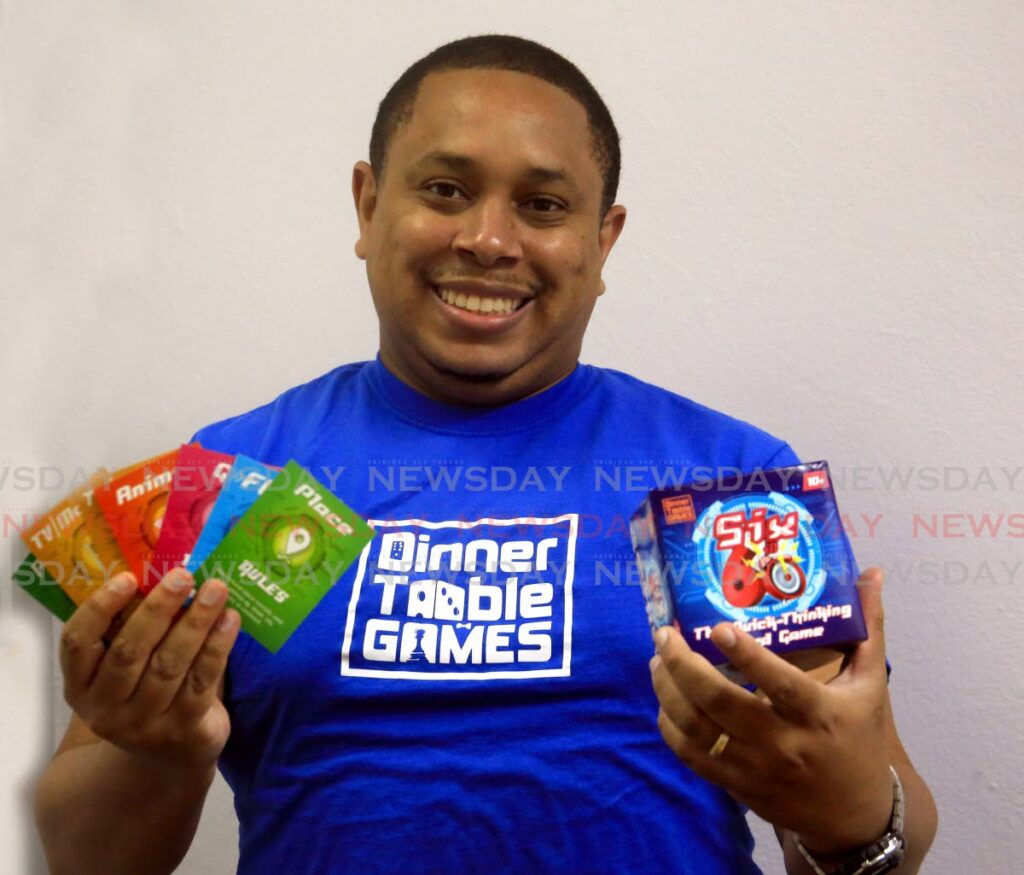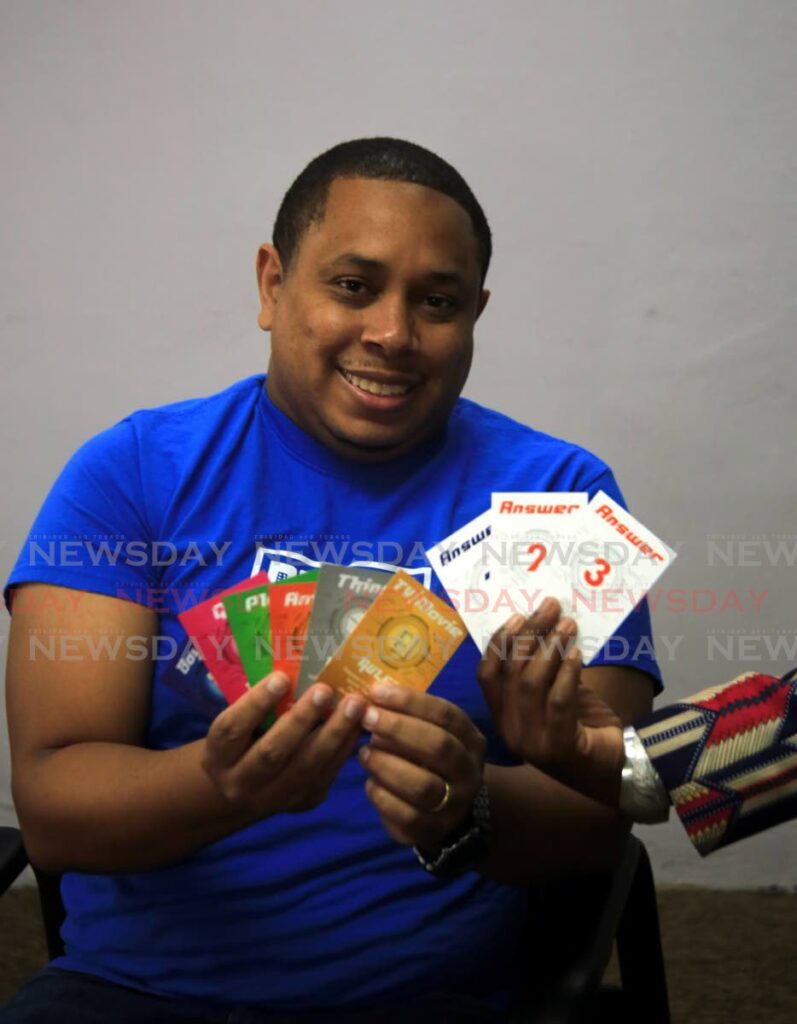Julien Neaves on Six in 60 – a game for everyone

Monopoly. Clue. Ludo. These are just some of the games many people share a common experience around: playing with friends and family.
In Trinidad and Tobago, many people can recall playing board games with loved ones.
This is the inspiration behind former Newsday journalist and communication specialist Julien Neaves’ latest game, Six in 60. This games falls under the wider brand of Dinner Table Games: a Caribbean-based board/card game development company.
Six in 60’s foundation is the local Boy, Girl, Animal, Place Thing game that many of us ruined copybooks playing.
The idea for Dinner Tables Games developed about ten years ago, he said. While heading to Tobago with friends, someone brought along the Man Bites Dog game.
“It is a game where you have different cards and you have to come up with headlines based on the cards.
“I have never seen the game before or after. Playing the game, I was like, ‘This game is so simple. I could make up a game.’
“From that I started making games for myself. I started with a story-based game. I had a word scramble game, variations of different games. But throughout all of that play testing, the one that I found people reacted well too was Six in 60 or the game that would become Six in 60.”

The game is for people ten and up and you can have solo players (one-six) or teams (two-six) with two-six players each.
Players are required to place the answer cards on a table or flat surface, horizontally and space out. Then they should shuffle each of the six-category card packs, turn those rules side up and place each under an answer card, left to right, in the order of Boy, Girl, Animal, Place, Thing and TV/Movie.
While the categories are the same as the game many played as children, it is different, Neaves said.
The main difference is in Six in 60 there are multiple categories with multiple letters and no writing whereas in boy, girl, animal, place, thing there is one letter and one must write the answer on sheets of paper.
There was a lot of trial and error before Six in 60.
Many of the games he created before were “sit down and concentrate games.”
He had never created one that could be played at a social event or party.
“So I had gone to a lime with another one of my games. I said, ‘Hey, let’s play the game.’ They wanted a party game, I had a sit down game and it was like a complete disaster.
“So I said let me get a party game. Something very easy. Something pick-up and play. It took me back to my days of playing Boy, Girl, Animal, Place, Thing, TV Show in primary school.
“I was like, ‘What if I do a party game version of that.’ My birthday parties were usually the testing grounds for my games because I have a captive audience.”
The original version of Six in 60 was created about six or seven years ago.
At that time, all of the categories were mixed up and it was a complete disaster and did not work, he said.

Seeking to constantly improve the game, he realised that it needed separate categories. That was when he had a light-bulb moment and the game, in its current form, was developed.
“I would keep testing it. I had a family day I took it to and I was playing it with one of my relatives who said, ‘If this game was in stores, I’d buy it.’”
At that time, he had four games in testing and Six in 60 was the one to which people responded.
Neaves largely sees his audience as being people in their 30s-40s.
A main objective for Neaves is to have families and friends gather around dinner tables playing and interacting again.
“I grew up playing Ludo and Monopoly with my family. Those are some of my best memories with my family. So the inspiration for the name of the company came from that.
“Let us get friends and family back, let’s sit down and play games.”
He also believes that it is a 30-plus audience that would crave Six in 60’s interactive experience.
“I love movies. I enjoy video games as well but the kind of interactivity and getting to know people with a table-top game is way far beyond any of those things.
“It is an extremely different experience,” he said.
He does not think that it might be as appealing to a younger audience as “a lot of them did not grow up playing games at the dinner table.”
He is open to introducing them to it through a digital version of the games.
Six in 60 would work, digitally, he said.

“What they say about the best games is the core concept of it. Once you have a strong core concept in your game, the other is just the periphery.”
Six in 60 can be turned into an app where people can play for themselves or compete with other players.
He added, however, that does not compare to the game being played in person.
Six in 60 is a game that can easily be played at the beach or while having friends over.
The game is one in a growing local gaming industry and TT is becoming more familiar with local games, Neaves said.
“We have games like Doh Say Dat, another from my good friend Warren Le Platte, Santimanitay. So there is an industry that is emerging. There are multiple versions of Monopoly too.
“So hearing there is a locally-made game is not a foreign concept. I think more people are warming up and people want to have local things as well too.”
He has also had interest from people abroad since the game’s introduction to market in May.
“The big plan is to get it up on Amazon. But I would love to go up the islands, go to trade shows and show off the game.”
Even though it was created, designed, printed and packaged in TT, it can be played anywhere in the world.
“I can go to Afghanistan and play this game and people would understand it,” Neaves said.
Getting the game printed was not an easy process for Neaves.
A prototype was done August last year and he began the search for a local printer.
“I would contact the printers and say, ‘I have this game. I want to do it.’ And there was a lot of back and forth. They were taking long to respond.”

He added that he worked with two printers and spent months with them, only to be eventually told they were unable to do it.
Luckily, his graphic designer introduced him to a printer who was able to get it done.
He initially printed 250 and plans to print 500 on the second run.
It is being sold on a local app called Unqueue. People can purchase the game online and then have it delivered to them using the app. People can also directly contact Neaves to purchase the game.
Neaves wants Dinner Table Games and Six in 60 to become household games.
He is already working on another game and hopes to have it out by December.
Dinner Table Games can be found on Facebook, Instagram and at dinnertablesgamestt@gmail.com.


Comments
"Julien Neaves on Six in 60 – a game for everyone"